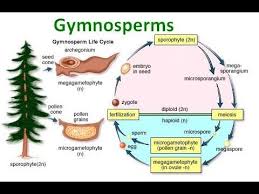In this article, generally, we shall be considering the life cycle of seed plants, the mode of reproduction in gymnosperms and angiosperms. In this article, we shall be looking, specifically, at reproduction in gymnosperms.
Generalized Life cycle of seed Plants
Seed plants are heterosporous that is they have 2 different spore sizes namely, the megaspores and microspores.
The generalized life cycle of plants has been modified (Fig 2.1) to illustrate plants which have separate male and female gametophytes (megagametophyte and microgametophyte) produced by different sized spores (megaspores and microspores).
 Fig 3.1 Generalized life cycle of a seed plant
Fig 3.1 Generalized life cycle of a seed plant
The evolutionary trend from nonvascular plants to seedless vascular plants to seed plants has been a reduction in the size of the gametophyte. In seed plants, the gametophyte is usually microscopic and is retained within the tissues of the sporophyte.
The megasporangium is surrounded by layers of sporophyte tissue called the integument. The integument and the structures within (megasporangium, megaspore) are the ovule.
Read Also : The Origin and Evolution of Seed Plants
Microspores germinate within the sporophyte tissue and become pollen grains. The microgametophyte is contained within the tough, protective coat of the pollen grain.
The entire microgametophyte (pollen grain) is transferred to the vicinity of the megagametophyte by a process of pollination. Wind or animals usually accomplish this transfer.
When pollen reaches the female gametophyte, it produces an elongate structure (pollen tube) that grows to the egg cell. Sperm are transferred directly through this tube to the egg. The advantage of this process is that sperm do not have to swim long distances as they do in seedless plants
The seeds of gymnosperms contain the sporophyte embryo, food for the embryo, and a protective coat.The embryo within the seed is dormant; it can survive for long periods without additional food or water. When conditions become favourable, the embryo resumes growth as the seed germinates. Gymnosperms have naked seeds.
Reproduction in Gymnosperm(Pine)
1. Microsporangia and Megasporangia
Spores (mega and micro) are produced by meiosis. Microspores are produced within protective structures called microsporangia; megaspores are produced within megasporangia.
In Fig 3.2 below, in pine, microsporangium is found within pollen cones.

Fig 3.2a Microsporangium: Male reproductive structure
Fig 3.2b Megasporangium: Female reproductive structures in a Pine .
Seed cones contain ovules. The structure diagrammed below (Fig 3.3a) is an ovuleand will develop into a seed. The integument will become the seed coat.
Fig 3.3a Diagrammatic structure of an ovule.
Megasporocytes (megaspore mother cells) are cells contained within the ovule produce four megaspores by meiosis (Fig 3.3b).
 Fig 3.3b Megasporocyte containing four megaspore Three of the megaspores die (fig 3.3c).
Fig 3.3b Megasporocyte containing four megaspore Three of the megaspores die (fig 3.3c).
 Fig 3.3c Megasporocyte containing only one megaspore.
Fig 3.3c Megasporocyte containing only one megaspore.
The remaining one develops into a femalegametophytewithout being released from the megasporangium (fig 3.3d).
 Fig 3.3d Megasporangium containing the gametophyte Female gametophytes function to produce eggs. (Fig 3.3f).
Fig 3.3d Megasporangium containing the gametophyte Female gametophytes function to produce eggs. (Fig 3.3f).
 Fig 3.3f Eggs formation by the gametophyte.
Fig 3.3f Eggs formation by the gametophyte.
 Fig 3.4. Diagrammatic illustration of Pine life cycle.
Fig 3.4. Diagrammatic illustration of Pine life cycle.
We have studied the development of ovules to the point of egg formation in gymnosperm. Let’s briefly take a look at how the flowers are pollinated and the subsequent fertilization of the egg
Pollination and Fertilization in Gymnosperm
The male gametophyte (pollen grains) consists of two cells. One small and is called a generative cell. The other, larger cell is a tube cell. The generative cell will later divide to produce two sperm. Pollination refers to the transfer of pollen to the vicinity of the egg.
The two wing-like structures on the pollen grain aid in enabling the pollen to be carried by the wind. After being transported by wind to a seed cone, the tube cell grows toward the egg, producing a pollen tube. The two sperm produced by the generative cell enter the pollen tube and move toward the egg.
Water is not required for reproduction. During pollination, the entire male gametophyte is transferred from the pollen cone to the seed cone. The sperm are not flagellated, so they remain within the tube cell and rely on the growth of a pollen tube to deliver them to the egg cell.
The fertilized egg (zygote) develops into an embryo which is contained within the seed. Seeds function as a mechanism of dispersal in seed plants. Seeds contain food and a protective coat (Seed Plant).
In conclusion, Gymnospermsare plants with naked seeds (no fruit). The sporophyte and gametophyte are the reproductive structures in the gymnosperms. The usual or normal reproductive processes take place in gymnosperms resulting in the formation of naked seeds
Seed plants have 2 different spore-size types: Megaspore and Microspore. The megaspore and the microspore are enclosed in a protective structure called Megasporangia and Microsporangia respectively.
Male gametophytes are produced from the microspore. Female gametophytes are produced from the megaspore. The integument becomes the seed coat. Seed cones contain ovules. Fertilized egg develops into an embryo. Gymnosperms are plants with naked seeds.
Read Also : Ways To Generate Income From Consumable Waste
Frequently Asked Questions
We will update this section soon.

